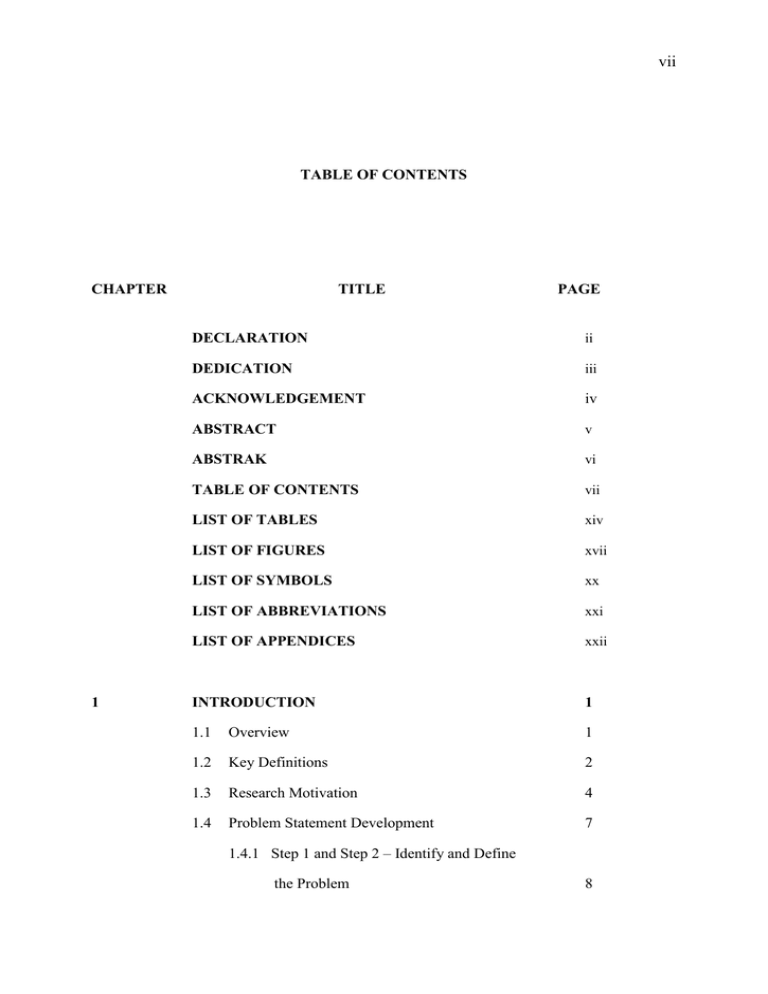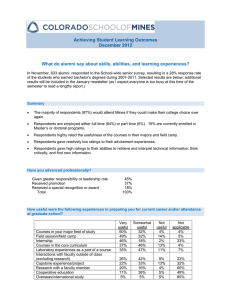vii
advertisement

vii TABLE OF CONTENTS CHAPTER 1 TITLE PAGE DECLARATION ii DEDICATION iii ACKNOWLEDGEMENT iv ABSTRACT v ABSTRAK vi TABLE OF CONTENTS vii LIST OF TABLES xiv LIST OF FIGURES xvii LIST OF SYMBOLS xx LIST OF ABBREVIATIONS xxi LIST OF APPENDICES xxii INTRODUCTION 1 1.1 Overview 1 1.2 Key Definitions 2 1.3 Research Motivation 4 1.4 Problem Statement Development 7 1.4.1 Step 1 and Step 2 – Identify and Define the Problem 8 viii 2 1.4.2 Step 3 – Select the Research Design 8 1.4.3 Step 4 – Determining Relevance 9 1.4.4 Step 5 – Cite Research 9 1.4.5 Step 6 – Share the Checklist 9 1.4.6 Research Problem Statement 11 1.5 Research Questions 11 1.6 Research Objectives 12 1.7 Research Significance 13 1.8 Research Scope 14 1.9 The Thesis Outline 16 LITERATURE REVIEW 18 2.1 Overview 18 2.2 Introduction 20 2.3 Information Systems Success 21 2.4 Enterprise Systems’ Critical Success Factors 21 2.5 Enterprise System Problems in Post- 2.6 Implementation Phase 24 Knowledge Management in Enterprise Systems 27 2.6.1 Mediating Role of Knowledge Management In Enterprise Systems 2.7 28 Knowledge Management and Knowledge Integration 32 2.7.1 Knowledge Integration 32 2.7.2 Knowledge Integration Studies in Enterprise Systems 34 ix 2.8 2.7.3 Knowledge Integration Mechanism 37 2.7.4 Knowledge and Leadership 42 Leadership and Enterprise Systems Success 44 2.8.1 Leadership Styles 46 2.8.2 Leadership Styles –Transformational and 2.9 Transactional Leadership 49 Enterprise Systems Related Knowledge 56 2.9.1 Organisational Knowledge 58 2.10 Management, Managers, Leaders and Leadership 59 2.11 Research Paradigm 61 2.11.1 Positivist Paradigm 2.12 Statistical Analysis 2.12.1 Statistical Method 2.13 Review of Theory 3 63 65 65 68 2.13.1 Enterprise Systems Success Dimensions 68 2.13.2 The Knowledge-Based Theory of the Firm 71 2.13.3 Mediator 72 2.14 Literature Map Diagram 74 2.15 Chapter Summary 76 RESEARCH METHODOLOGY 77 3.1 Overview 77 3.2 Research Strategy Diagram 78 3.3 Statistical Instrument 80 3.3.1 SmartPLS 81 3.3.2 Statistical Package for the Social Science 82 x 3.4 3.5 The Relationship between the Construct and the Measure 83 3.4.1 Reflective Measurement Model 84 3.4.2 Formative Measurement Model 85 Research Design 85 3.5.1 Literature Survey 88 3.5.2 Definition of the Research Problem 88 3.5.2.1 Preliminary Study 89 3.5.3 Theoretical Model and Research Hypotheses 3.5.4 90 Conducting of the Survey 91 3.5.4.1 Survey Instrument Development 91 3.5.4.2 Population and Sample-The Generalisation 108 3.5.4.3 Sampling Technique 109 3.5.4.4 Sampling Design 110 3.5.4.5 Common Methods Bias and Common Method Variance 113 3.5.4.6 Research Assumptions 114 3.5.4.7 Control Variables 115 3.5.4.8 Pre-Test 116 3.5.4.9 Pilot Study 117 3.5.5 Data Analysis and Interpretation of 3.6 Findings 128 3.5.5.1 Goodness-of-fit Index 131 3.5.6 Communicate the Contributions 131 Chapter Summary 131 xi 4 RESEARCH MODEL DEVELOPMENT 133 4.1 Overview 133 4.2 Research Hypotheses of Leadership towards Enterprise Systems Success 134 4.2.1 Transformational Leader in Enterprise Systems Success 4.2.2 134 Transactional Leadership Enterprise Systems Success 4.3 Leadership Model Diagram 4.4 Research Hypotheses Knowledge Integration Mechanisms as a Mediator 135 137 138 4.4.1 Transformational Leadership and Knowledge Integration in Enterprise Systems Success 138 4.4.2 Transactional Leadership and Knowledge Integration in Enterprise Systems Success 139 4.4.3 Mediating the Effect of Knowledge Integration 5 Adoption 140 4.5 Research Model Diagram 141 4.6 Chapter Summary 142 ANALYSIS, RESULTS AND DISCUSSION 143 5.1 143 Overview 5.2 The Company Profile Overview 144 5.3 Actual Study 146 5.4 148 Actual Study Data Analysis xii 5.4.1 Descriptive Analysis-Skewness, Kurtosis, Mean and Standard Deviation 148 5.4.2 Analysis of Reliability and Validity 149 5.4.3 Structural Measurement Model 155 5.4.3.1 Step 1: Collinearity Isues 155 5.4.3.2 Step 2: Structural Model Path Coefficient 156 5.4.3.3 Step 3: Coefficient of Determination, R2 5.4.3.4 Step 4: Effect Size, f2 5.5 Hypotheses Analysis 163 165 167 5.5.1 H1:Transformational Leadership is Not Positively Related to ES Success Dimensions 167 5.5.2 H2:Transactional Leadership is Not Positively Related to ES Success Dimensions 168 5.5.3 H3:Transformational Leadership is Positively Related to KI Mechanism 169 5.5.4 H4:Transactional Leadership is Positively Related to KI Mechanism 170 5.5.5 H5: KI Mechanism Mediates the Relationship between Two Leadership Styles and ES Success 5.6 171 5.5.6 Analysis of KI Mechanism Construct 172 5.5.7 Summary of Hypotheses Analysis 175 Additional Findings 176 5.6.1 Frequency Analysis of Exegenous Construct 176 xiii 6 5.6.2 Outer Weight 184 5.6.3 Frequency Analysis of the Cohort 185 5.7 Future Research 190 5.8 191 Chapter Summary CONCLUSION AND RESEARCH CONTRIBUTION 192 6.1 Overview 192 6.2 Contribution of the Research 193 6.2.1 Contribution to Theory 195 6.2.2 Contribution to Managerial Practise 198 6.3 Conclusion 201 6.4 Chapter Summary 202 REFERENCES Appendices A-E 203 229-278 xiv LIST OF TABLES TABLE NO. TITLE 1.1 Organisation of Chapter 1 1.2 Problem statement checklist development (Blum and PAGE 2 Preiss, 2005) 10 1.3 Research questions 12 2.1 Organisation of Chapter 2 19 2.2 Critical success factors literature 22 2.3 ES post-implementation activities studied from 2006 to 2013 26 2.4 Mediating role of KM in ES literature 30 2.5 Knowledge integration studies in enterprise systems 37 2.6 Leadership styles in ES success literature, 2011–2014 48 2.7 Intellectual stimulation types (Bass, 1985) 52 2.8 Two types of contingent reward (Bass, 1985) 54 2.9 Studies of organisational knowledge, 1994–2014 59 2.10 Definitions of management, managers, leaders, and leadership 2.11 Overview of the positivist, critical and interpretive paradigms 2.12 3.1 63 Organisation of multivariate methods (Hair et al., 2013, p. 2) 2.13 61 66 Rules of thumb for choosing between PLS-SEM and CB-SEM 67 Organisation of Chapter 3 77 xv 3.2 Data considerations when applying PLS-SEM (Hair et al., 2013) 81 3.3 Steps 2 and 3 of survey instrument development process 100 3.4 Guidelines for choosing the measurement model mode 101 3.5 Systematic evaluation of PLS-SEM results – Stage 5 102 3.6 Rules of thumb for evaluating reflective measurement model 3.7 102 Rules of thumb for evaluating formative measurement models 103 3.8 Rating scale for leadership style constructs 106 3.9 Rating scale for KI mechanisms construct 106 3.10 Rating scale for ES success construct 107 3.11 Pilot study survey dissemination 118 3.12 Fornell–Larcker criterion 123 3.13 Assessment of collinearity issues and significance and relevance 127 4.1 Organisation of Chapter 4 134 5.1 Organisation of Chapter 5 144 5.2 Sample size (based on Bartlett et al. (2001)) 148 5.3 Fornell–Larcker criterion 152 5.4 Assessment of collinearity issues and significance and relevance 154 5.5 Collinearity issue assessment 155 5.6 Significance testing results of the structural model path coefficient 156 5.7 Significance testing results of the total effect 157 5.8 Significance analysis of path coefficients without mediator 5.9 159 Assessment of R2 value 2 5.10 Summary of f results 5.11 Frequency and percentage of respondents’ ratings for rules and directives 164 166 172 xvi 5.12 Frequency and percentage of respondents’ ratings for routine 173 5.13 Indicators’ outer loading of KI mechanism construct 175 5.14 Frequency and percentage of respondents’ rating for transformational leadership style 5.15 Frequency and percentage of respondents’ ratings for transactional leadership style 5.16 181 Frequency and percentage of respondents’ ratings for IS quality 5.20 180 Frequency and percentage of respondents’ ratings for information quality 5.19 179 Frequency and percentage of respondents’ ratings for organisational impact 5.18 178 Frequency and percentage of respondents’ ratings for individu impact 5.17 177 182 Indicators’ outer weight and outer loading of exogenous Construct 185 5.21 Frequency and percentage of respondents’ positions 186 5.22 Frequency and percentage of respondents’ departmental environment 5.23 Frequency and percentage of respondents’ experience using an ES 5.24 187 188 Frequency and percentage of respondents’ education level 189 5.25 Tools/applications/procedures used in the analysis 191 6.1 Organisation of Chapter 6 192 6.2 Practical guidelines for KI practise in ES postimplementation phase 199 xvii LIST OF FIGURES FIGURE NO. TITLE 2.1 Knowledge silos as a result of no KI (Group, 2006) 2.2 Four categories of knowledge assets (Nonaka et al., 2000) 2.3 PAGE 33 43 Types of ES-related knowledge (Chan and Rosemann, 2001) 57 2.4 IS impact measurement model (Gable, 2008) 69 2.5 Prior model of Gable’s IS impact measurement model 70 2.6 General mediator model (Hair et al., 2013, p. 220) 73 2.7 Literature map diagram 75 3.1 Research strategy diagram (Ahmad , 2009 and Geerts, 2011) 3.2 79 The present study design diagram adapted from Yin (2003) 87 3.3 Literature review sources and output 88 3.4 The present study development of theoretical model and hypotheses 3.5 91 Scale development procedure (Mackenzie et al., (2011) and PLS-SEM (Hair et al., 2013, p. 47) 95 3.6 Survey instrument development design diagram 96 3.7 Development of construct conceptual definition (McKenzie et al., 2011) 3.8 97 Assessment of reliability and validity for reflective measurement model 104 xviii 3.9 Assessment of validity and collinearity for formative measurement model 105 3.10 Composite reliability result 120 3.11 Indicators’ outer loading of the reflective construct 121 3.12 Average variance extracted 121 3.13 Indicators’ cross-loading values 122 3.14 Redundancy analysis of transformational leadership constructs 3.15 124 Redundancy analysis of transactional leadership construct 124 3.16 Redundancy analysis of ES success construct 125 3.17 Steps in structural model assessment procedure (Hair et al., 2013) 129 4.1 Leadership styles model towards ES success 137 4.2 KI as Mediator between Leadership Styles torward ES Success 142 5.1 Composite reliability result 149 5.2 Indicator outer loading of reflective construct 150 5.3 Average variance extracted (AVE) 150 5.4 Indicators’ cross-loading values 151 5.5 Redundancy analysis of transformational leadership construct 5.6 152 Redundancy analysis of transactional leadership construct 153 5.7 Redundancy analysis of ES success construct 153 5.8 Results of the hypotheses significance testing 156 5.9 Mediator analysis procedures in PLS-SEM (Hair et al., 2013, p. 224) 158 5.10 Direct effect 159 5.11 Indirect effect 160 5.12 Standard deviation calculation using MS Excel spreadsheet 161 xix 5.13 PLS path model with R2 value and path coefficient 5.14 Frequency bar chart of the respondents’ ratings for rules and directives 5.15 181 Frequency bar chart of the respondents’ ratings for information quality 5.21 180 Frequency bar chart of the respondents’ ratings for organisational impact 5.20 178 Frequency bar chart of the respondents’ ratings for individu impact 5.19 177 Frequency bar chart of the respondents’ ratings for transactional leadership 5.18 173 Frequency bar chart of the respondents’ ratings for transformational leadership 5.17 172 Frequency bar chart of the respondents’ ratings for organisation routine 5.16 164 182 Frequency bar chart of the respondents’ ratings for IS quality 183 5.22 Frequency bar chart of the respondents’ positions 186 5.23 Frequency bar chart of the respondents’ departmental environment 5.24 5.25 187 Frequency bar chart of the respondents’ experience using an ES 188 Frequency bar chart of the respondents’ education level 189 xx LIST OF SYMBOLS - Probability of Type I error R2 - Coefficient of Determination 2 - Effect Size f xxi LIST OF ABBREVIATIONS CSFs - Critical Success Factors ES - Enterprise Systems GoF - Goodness-of fit index KBT - Knowledge Based Theory KI - Knowledge Integration KM - Knowledge Management IS - Information Systems IT - Information Technology PLS - Path modelling SEM - Structural Equation Modelling SD - Standard Deviation SLR - Systematic Literature Review VIF - Variance Inflation Factor VAF - Variance Accounted For xxii LIST OF APPENDICES APPENDIX TITLE PAGE A Expert Review 229 B Pilot Test Result of the Descriptive Statistics 264 C Actual Test Result of the Descriptive Statistics 268 D Questionnaires 272 E Publications 278


